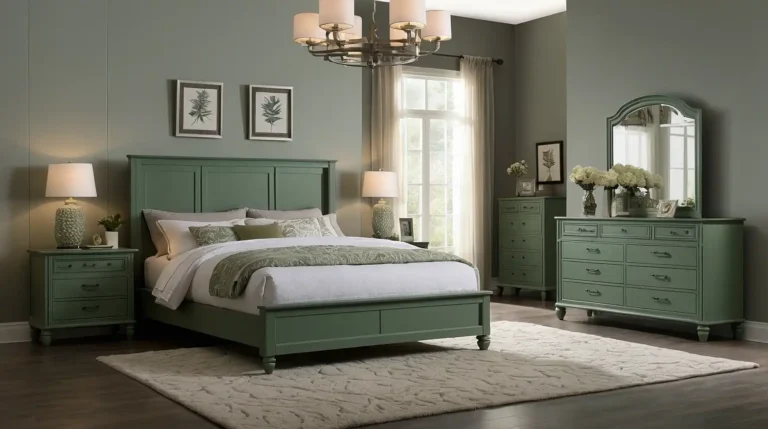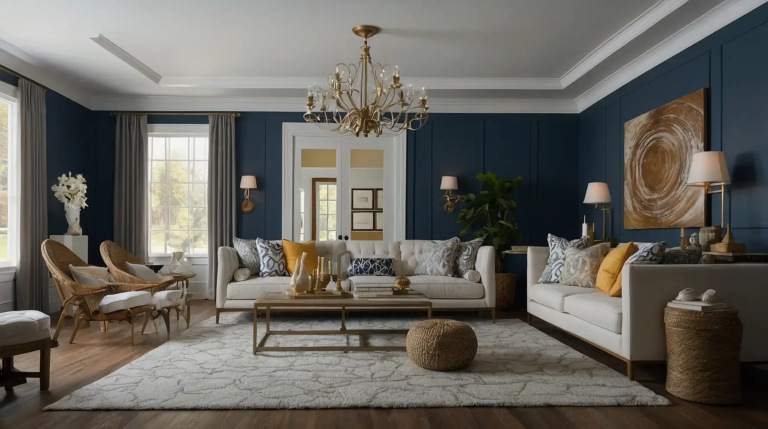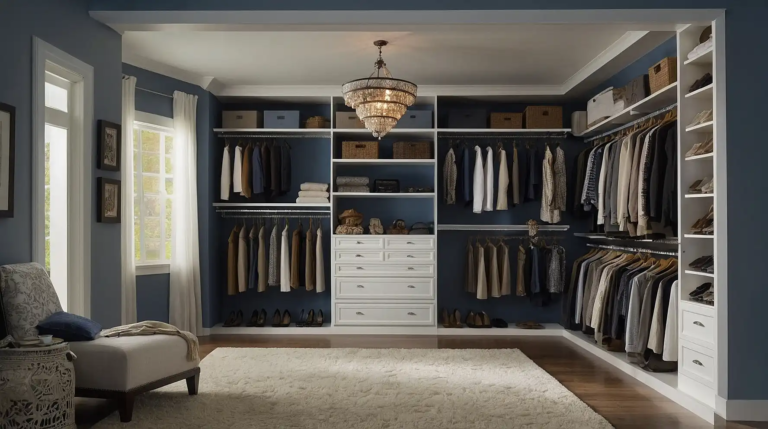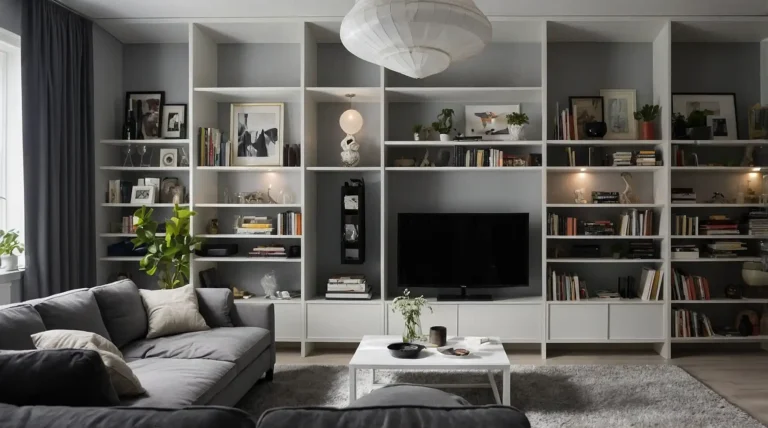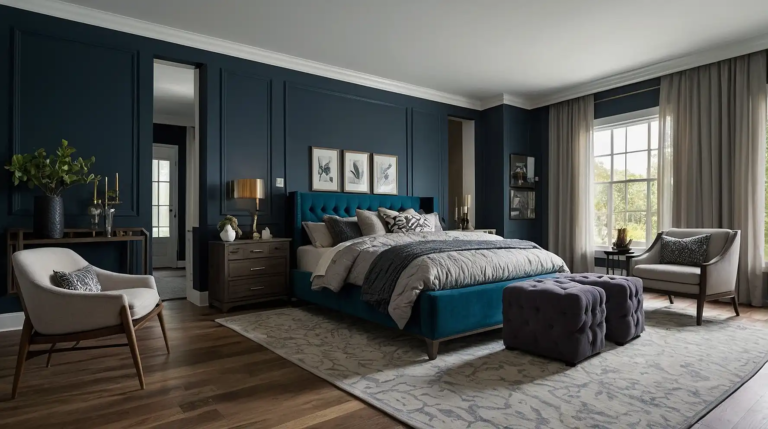35 Creative Photo Wall Arrangement Ideas That Showcase Your Family Memories
Family photos transform houses into homes, filling walls with cherished memories and personalities.
But arranging these precious images can feel overwhelming without a clear vision or plan.
With the right layout strategy, your family photos can become a stunning art display that tells your unique story.
These arrangements work in any space, from grand entryways to cozy hallways or intimate living areas.
Ready to transform your blank walls into personalized galleries of joy?
Explore these 35 photo wall arrangement ideas that will help you showcase your most treasured family moments in style.
1: Classic Grid Formation

Create a clean, organized display by arranging identical frames in perfect rows and columns.
This structured approach brings order to multiple photos while making a cohesive statement.
Choose matching frames in a finish that complements your décor. The uniformity creates a gallery-like presentation that elevates even casual snapshots.
Maintain precise spacing between frames (typically 2-3 inches) to preserve the grid’s visual impact and create a polished, professional appearance.
2: Organic Cluster Arrangement

Break free from rigid layouts with a free-flowing cluster of varied frame sizes and styles. Begin with a central anchor photo and expand outward organically.
Leave equal space between frames to maintain visual cohesion despite the varied shapes.
This arrangement works beautifully around furniture pieces or architectural features.
The relaxed, collected-over-time appearance tells a more casual family story while still creating intentional design impact.
3: Floor-to-Ceiling Photo Column

Maximize narrow wall spaces by creating vertical columns of stacked photos. This arrangement works perfectly in hallways, beside doorways, or between windows.
Align frames along their centers or edges for a organized appearance despite varying widths.
Consider thematic grouping within each column—perhaps chronological or by family member.
This space-efficient approach allows you to display many photos in areas typically overlooked for decorative potential.
4: Geometric Shape Formation

Arrange your photos to form a larger geometric shape—a heart, hexagon, circle, or diamond.
This creative approach turns individual memories into a unified artistic statement.
Plan your shape on the floor before hanging, using painter’s tape to mark boundaries. Start with the outline photos, then fill in the shape working inward.
This conversation-starting arrangement adds an extra layer of meaning to your display, especially when the shape itself holds significance to your family.
5: Timeline Chronology Display

Document your family’s journey by arranging photos in chronological order.
Create a horizontal timeline along a hallway or wraparound design in a living space.
Include small tags with dates or ages for context if desired. This arrangement tells your family’s story with a clear narrative progression that visitors can follow.
Consider leaving space at the end for future additions, acknowledging that your family story continues to grow.
6: Identical Frame Sunburst

Create dramatic visual impact by arranging identical square or circular frames in a sunburst pattern radiating from a central point.
This dynamic formation transforms simple photos into an artistic installation.
Maintain equal spacing between frames and consistent distance from the center point.
For perfect placement, use string attached to the center point as a radius guide.
This eye-catching arrangement works particularly well with black-and-white photos for a cohesive, sophisticated statement.
7: Different Sized Frames Staircase Gallery

Transform your staircase wall into a dynamic gallery that ascends with your steps. Follow the staircase angle with frames that create parallel lines to the stair slope.
Mix frame sizes while maintaining consistent spacing and alignment with the stairs.
This architectural approach integrates your photos with your home’s structure.
The ascending arrangement creates natural movement, guiding visitors upstairs while giving them something beautiful to view along the journey.
8: Family Tree Visualization

Design a literal family tree with photos arranged on branches extending from a painted or decal trunk.
Place older generations at the bottom, with newer additions toward the top.
Include small identifying labels if desired for extended family members.
This arrangement gives children a visual understanding of their heritage and connections.
Consider using frame colors or styles to differentiate family branches or generations within your overall design.
9: Oversized Statement Piece

Create dramatic impact with one enormously enlarged family photo as a focal point, surrounded by smaller complementary images.
The scale hierarchy immediately draws attention.
Choose an exceptional image with emotional significance for the central enlargement.
The surrounding smaller photos should relate thematically to the main image.
This arrangement creates a clear focal point while still allowing you to display multiple memories in a cohesive, intentional design.
10: Floating Shelf Photo Ledge

Install floating picture ledges to create flexible, changeable photo displays without multiple wall holes. Overlap frames slightly for depth and arrange in varied heights.
This approach allows for easy seasonal rotation of images without rehanging.
Simply slide frames along the ledge or swap out photos entirely as your collection grows.
The dimensional quality of leaning (rather than hanging) frames adds architectural interest while creating a more casual, curated appearance.
11: Black and White Consistency

Unify diverse photos by converting all images to black and white.
This cohesive treatment elevates casual snapshots to artistic status while creating visual harmony.
Combine different eras, subjects, and photo qualities without discord.
The monochromatic palette focuses attention on expressions and connections rather than varying color schemes.
This sophisticated approach works with any interior design style and creates timeless appeal that won’t clash with changing room colors.
12: Photo Collage Letters

Arrange photos within large letter-shaped frames that spell meaningful words like “FAMILY,” “HOME,” or your surname.
This typographic approach combines graphic impact with personal imagery.
Purchase pre-made letter frames or create your own from cardboard templates.
Fill completely with overlapping photos for a dense, layered effect rich with memories.
This creative arrangement functions as both wall art and conversation piece, drawing visitors in to discover the images within the overall pattern.
13: Corner Wraparound Gallery

Extend your photo display around corners to create a continuous gallery that unifies adjacent walls.
This technique activates often-underutilized corner spaces while creating flow.
Maintain consistent spacing as the display wraps the corner. Consider using similar frames or photo treatments to strengthen the connection between the walls.
This expansive approach works particularly well in open floor plans where wall space may be limited but corners provide additional display opportunities.
14: Floor-to-Ceiling Salon Style

Cover an entire wall with frames in a traditional salon-style hanging that fills the space from floor to ceiling.
This immersive approach creates dramatic visual impact.
Mix frame sizes, styles, and orientations while maintaining some organizing principle—perhaps color theme or subject matter.
The density creates a maximalist statement full of discoveries.
Leave small, consistent spaces between frames to prevent a cluttered appearance despite the fullness of the arrangement.
15: Single Color Frame Collection

Create unity with diverse frame styles by painting all frames one consistent color.
This technique allows for collecting interesting frame shapes while maintaining visual cohesion.
Choose a color that either contrasts with or complements your wall color. The matching frames create structure despite varying photo sizes and subjects.
This approach offers flexibility to incorporate frames from different sources while still achieving a purposeful, designed appearance.
16: Photo Grid With Featured Center

Design a symmetrical grid with a larger central image as the focal point.
Surround the feature photo with smaller, uniformly sized frames that complete the rectangular formation.
Choose a particularly significant or beautiful image for the central position.
The surrounding photos should complement or relate to the featured image thematically.
This balanced arrangement creates immediate visual hierarchy while still allowing you to display multiple memories in an organized fashion.
17: Travel Map Photo Integration

Display vacation photos alongside a large map, using string or ribbons to connect images to their locations.
This interactive display tells your family’s travel story geographically.
Include small tags with dates or memorable quotes from each trip.
The map provides context that enhances the meaning and memories associated with each image.
This educational arrangement works particularly well in children’s spaces or family rooms where stories are frequently shared and discussed.
18: Seasonal Rotation Gallery

Install a permanent frame arrangement but swap photos seasonally to keep your display fresh and relevant.
This approach maintains your carefully planned layout while allowing content flexibility.
Create a digital template marking frame positions and sizes for easy reference when changing photos.
Consider color themes or subjects that reflect each season or holiday.
This evolving gallery keeps your space dynamic while allowing you to display more of your photo collection throughout the year.
19: Photo Ledge Layering

Arrange multiple floating photo ledges at varying heights to create a three-dimensional display wall.
Place frames of different sizes on each ledge, overlapping slightly for depth.
Incorporate small objects or mementos among the frames to add personal significance.
The ability to layer and adjust creates a curated, collected-over-time appearance.
This flexible system allows for frequent updates without rehanging, perfect for families who take photos regularly and want to display recent memories.
20: String Light Photo Display

Combine illumination and imagery by clipping photos to strands of string lights.
This whimsical arrangement adds warm ambient lighting while showcasing your favorite memories.
Use small wooden or decorative clips to attach photos without damage.
The soft illumination creates a magical quality, particularly appealing in teen rooms or cozy nooks.
This temporary display method allows for easy seasonal changes and works well for recent photos you want to highlight before potentially framing.
21: Hexagonal Pattern Arrangement

Create visual interest with frames arranged in a honeycomb pattern of hexagons.
This geometric approach transforms standard rectangular frames into a contemporary art installation.
Maintain consistent spacing between frames to preserve the pattern.
Consider using frames of similar sizes or styles to emphasize the hexagonal arrangement rather than the frames themselves.
This modern, somewhat unexpected layout adds architectural interest while accommodating your precious family images within a designer-worthy display.
22: Washi Tape Frame Alternatives

Skip traditional frames entirely by creating colorful washi tape “frames” directly on your wall.
This budget-friendly approach adds playful color while highlighting your photos.
Extend the tape about one inch beyond your photo edges to create the frame effect.
Mix tape colors and patterns for a festive appearance or stick with one color for a more cohesive look.
This renter-friendly option creates zero wall damage while allowing for frequent changes and updates to your display.
23: Built-In Niche Gallery

Transform a recessed wall niche or built-in shelf into a dedicated photo display area. The architectural framing creates a natural boundary for your collection.
Paint the niche interior a contrasting color to make photos pop. The defined space naturally draws attention and creates a sense of intentional curation.
This approach makes use of existing architectural features while creating a distinctive, almost museum-like presentation for your family memories.
24: Clipboard Photo Display

Mount clipboards to your wall for an industrial-modern photo display that allows for easy image swapping.
The clipboards themselves become a graphic element in your design.
Arrange in a grid or organic pattern depending on your style preference.
The utilitarian quality of clipboards creates interesting contrast with intimate family moments.
This flexible system works particularly well in home offices, craft rooms, or other spaces where functional aesthetics are appreciated.
25: Wall Decal Photo Frames

Apply decorative vinyl decals around unframed photos for a playful, custom “frame” effect.
This lightweight approach creates visual interest without adding physical bulk to your walls.
Choose decals that complement your interior style—from ornate Victorian-inspired frames to minimalist geometric shapes.
The flat application maintains a sleek profile while defining each image.
This affordable alternative to traditional frames works especially well for temporary displays or children’s spaces where flexibility matters.
26: Polaroid-Style Cluster

Create a youthful, nostalgic display with photos printed in classic Polaroid format (or modern Instax size). Arrange in a casual cluster that suggests spontaneity.
Secure with minimally visible pins or washi tape for a floating effect.
The white borders of Polaroid-style prints create natural framing without additional materials.
This relaxed arrangement brings a documentary feel to your display, celebrating everyday moments rather than just formal portraits.
27: Around-the-TV Gallery

Transform the typically empty wall space around your television into a purposeful photo gallery. Arrange frames to create a deliberate border around the screen.
Maintain adequate spacing between frames and the TV to prevent visual crowding.
Consider using frames that complement your media console or other room furnishings.
This practical approach acknowledges the TV’s presence while balancing its technological appearance with personal, humanizing elements.
28: Ascending Size Arrangement

Create dynamic visual movement by arranging frames in ascending or descending size order.
This intentional progression draws the eye across your wall in a specific direction.
Start with your smallest frame and gradually increase size across the arrangement.
Consider maintaining similar style frames to emphasize the size progression rather than frame differences.
This contemporary approach brings subtle sophistication to your display while creating intentional visual rhythm across your wall.
29: Photo Wall with Dimensional Objects

Incorporate three-dimensional objects among your framed photos for added texture and personal significance.
Mix in small shelves holding meaningful mementos related to the images.
Balance the weight and visual density of objects with your photos. The varied depths create interesting shadows and a more immersive, museum-like quality.
This layered approach tells a richer family story by including physical artifacts alongside the photographic memories that capture your history.
30: Kid-Height Family Display

Create a dedicated photo gallery at children’s eye level featuring images of extended family members.
This thoughtful arrangement helps young children connect with relatives they may see infrequently.
Include simple labels with names and relationships. Position this lower gallery in children’s rooms or playspaces where they interact with it regularly.
This intentional display helps build family identity and connection, especially important for geographically dispersed families or preserving connections to older generations.
31: Magnetic Photo Wall

Cover a wall section with magnetic paint or attach a decorative metal sheet to create a flexible, changeable photo display surface.
Use decorative magnets to secure photos. Skip frames entirely for a more casual, bulletin-board effect.
The easy changeability encourages frequent updates with recent photos or children’s artwork.
This interactive display method works particularly well in family command centers, kitchens, or other high-traffic areas where photos are frequently viewed and discussed.
32: Split Photo Series

Create dramatic impact by printing one large image across multiple frames, creating a split-panel effect.
This contemporary approach transforms a single photo into an artistic installation.
Choose an image with strong composition that works well divided.
Landscape vistas, family portraits against simple backgrounds, or architectural images typically split effectively.
The multi-frame presentation adds unexpected sophistication to a favorite photo while creating a larger-scale presence than standard framing allows.
33: Illuminated Photo Shelf

Install LED strip lighting beneath floating photo shelves to add subtle illumination to your display.
This lighting technique adds drama while highlighting your cherished images.
Position the light strips to cast a gentle glow without creating harsh reflections on glass frames.
The warm illumination creates museum-quality presentation for everyday family photos.
This elevated approach works particularly well in hallways or dining areas where ambient lighting enhances the atmosphere during evening hours.
34: Picture Rail Hanging System

Install a traditional picture rail molding system that allows for hanging photos from decorative cords or ribbons.
This flexible approach permits frequent rearrangement without additional wall damage.
Vary the hanging lengths to create vertical interest and layering. The visible hanging system adds a decorative element while providing practical flexibility.
This classic display method brings traditional elegance to contemporary homes while acknowledging that family photo collections continuously evolve and grow.
35: Themed Color Story Photos

Curate photos with a consistent color theme running throughout—perhaps blue tones, golden hours, or images with pops of red.
This thoughtful selection creates visual harmony despite varied subjects.
Arrange these color-coordinated images in a cohesive gallery.
The unified color palette creates sophisticated impact while still showcasing diverse family moments.
This designer approach elevates casual snapshots to intentional art through thoughtful curation and color theory application.
Conclusion
Transform your empty walls into personalized galleries that tell your family’s unique story.
Whether you prefer structured elegance or casual creativity, these photo display ideas will showcase your cherished memories in style. Which arrangement will you create first?


